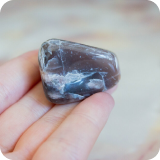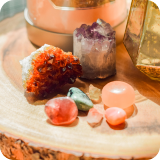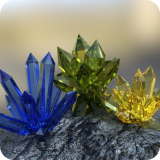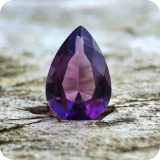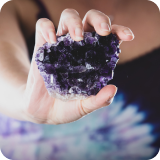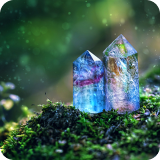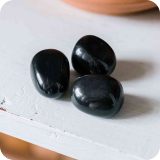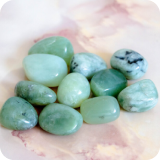- What Does a Real Ruby Look Like? 9 Things To Remember
- Types of Rubies
- How To Tell if Ruby Is Real: 7 Tests
- How To Spot a Fake Ruby: 5 Telltale Signs
- Verdict: Real Ruby Vs. Fake Ruby
Are you wondering if your Ruby is a fake? It took 400 years for the world to realize that Black Prince’s Ruby on the British Imperial State Crown is a Spinel, so knowing the differences between real Ruby versus fake Ruby is crucial. What are these differences? How to Identify Real Rubies?
The differences between a real versus fake Ruby are red to pink color with blue or purple tones, hexagonal structure, white streak, red fluorescence, color change, inclusions like rutiles, spots, silk, feathers, needles, cracks, fractures, fingerprints, or minerals.
If you’re trying to differentiate real Rubies from fakes, I’ll give you a foolproof checklist with its physical traits and varieties. Plus, there are 8 tests to identify real Rubies toward the end.
What Does a Real Ruby Look Like? 9 Things To Remember
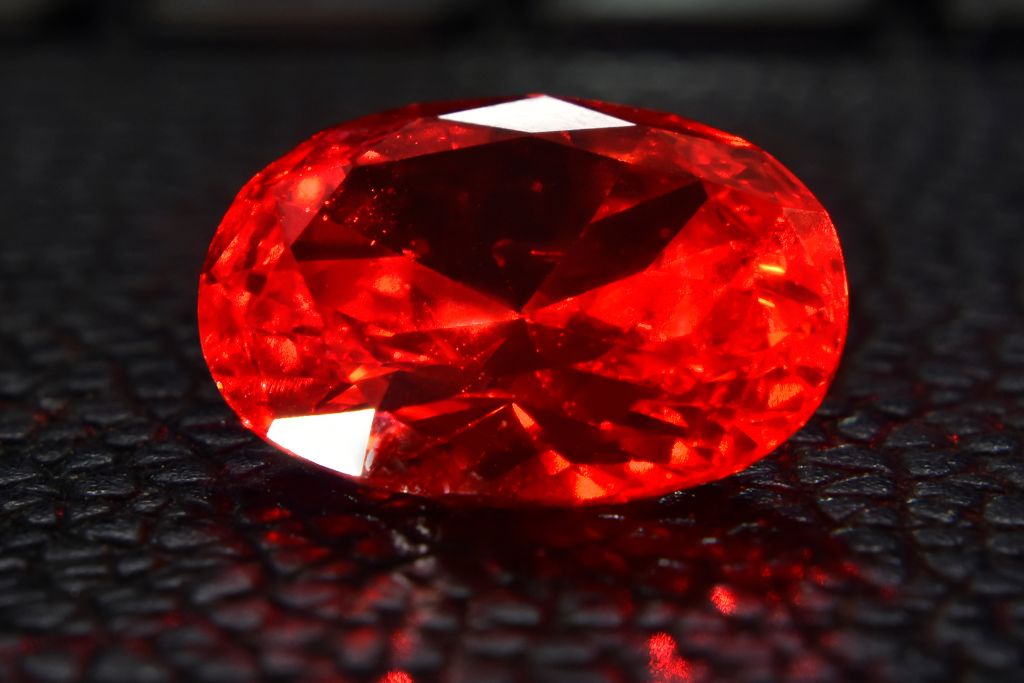
Many people have been scammed for thousands of years for selling fake precious stones like Rubies, Diamonds, and Sapphires.
The key is not looking at a single trait but several at once.
Fun Fact: Ruby is also called Red Corundum, Rubis, Rubin, Errubi, Rubino, Yakut, Rubiin, and Rubi.
Color and Color Variations in a Real Ruby
Observing the stone’s color with a magnifying loupe tells you if it’s a genuine Ruby. Natural rubies may show pink or deep/dark red hues with purple or blue tones, although their colors vary by variety and origin.
Fraudsters try to pass off dyed Garnets, Spinels, Tourmalines, and even red glass without the same depth of color. Fake Rubies may even have an orange or yellow tone.
Crystal Structure of a Certified Ruby
Most gemologists identify real Rubies by their hexagonal structure. It’s a distinguishing marker since no other red stone has it (except some Tourmalines). Some varieties may even show a visible hexagonal structure.
Under the magnifying loupe, some Rubies show a six-sided star-shaped pattern. If the internal structure of your stone is cubic, it may be a Garnet or Spinel than Rubis. Glass shows an amorphous structure.
Red Tourmaline may also show a trigonal or hexagonal crystal structure, so test for other characteristics, like Ruby hardness and fluorescence.
Luster in a Legitimate Ruby
Genuine Ruby may have a vitreous (glassy), resinous (oily or greasy), adamantine (diamond-like), or sub-adamantine (metallic) luster. Top-grade Burmese Rubies show a brilliant sparkle, mimicking Red Diamonds.
Fake Rubies may have varying or unreal luster. If the glass is used, the fake Ruby may look shiny or vitreous. Synthetic Rubies have a duller luster than natural Rubies.
If your stone is brilliant when viewed through a magnetic loupe, there’s a higher chance it’s a real Ruby.
Transparency and Inclusions in Authentic Ruby
Natural gemstones are transparent, as they allow light to pass through them. That’s why natural Rubies are clear.
Inclusions in Rubies are minor and scattered but may vary from silk fibers to spots, feathers, rutiles, needles, cracks, fractures, fingerprints, and minerals.
Fakes, like glass, may show bubbles, sometimes with parallel stripes or foggy insides. Some fake Rubis stones have a deep coating that mimics real rubies.
Among genuine Rubies, Burmese, Sri Lankan, and Madagascar varieties boast the highest clarity and transparency.
Growth Lines in a Natural Ruby
Did you know growth lines are called Rutile Silk in Rubies? Growth variations in the real Rubies lead to irregular white, pink, black, purple, and red striations.
Unlike genuine Rubies, Synthetic Rubies have uniform striations and fake Rubies show parallel or straight bands.
Texture of a Real Ruby
While raw Rubis has an erratic and rough texture, their polished counterparts are smooth on the surface. The exterior might sometimes be lumpy due to protruding mineral inclusions. Fake Rubies show grainy textures with artificial inclusions, striations, or bubbles.
Optical Illusions in a True Ruby
Depending on the type of inclusions, Rubies may show different optical phenomena on top of fluorescence. Real Rubies are described with a “fire” inside them, making them glow and change colors under different lights.
- Pleochroism: Ruby shows a strong pleochroism (different colors from different angles) with a deep red along the axis and light pink crosswise.
- Color Change: Most Rubies change their color from a pinkish-red tone in daylight to a brownish-red tone at night under incandescent light.
- Asterism or Star Effect: A Ruby may reflect light in a six-legged star shape due to rutiles. The star won’t move with your movements in fake Star Rubies, as it may be painted or engraved.
- Fluorescence: Most Rubis stones are strongly fluorescent under long-wave UV light, which is absent in fakes. Synthetic Rubies have stronger fluorescence than real rubies.
Cost of Real Ruby
Two centuries ago, natural Rubis stones cost $800 per carat. Today, they cost $1,000 to $15,000 per carat. That said, you can get low-quality natural Rubies for $5 to $100 these days.
Did you know Rubies were costlier than Diamonds during the Middle Ages in Europe? Even today, rare Rubies in vibrant red hues with high clarity fetch the highest prices, followed by large natural specimens.
You can get fake Rubies for less than a dollar these days.
Synthetic Rubies are more affordable but not as cheap as fake ones because they possess all the traits of natural Rubies except for their origin. Did you know the Synthetic Ruby value used to be $1,000 per carat a century ago? They’ve come down to $2 to $5 per carat today.
Fun Fact: The costliest Ruby in the world is the 25.59 carats Sunrise Ruby worth $30 Million.
Size of a Natural Ruby
Natural Rubies may be tiny or large, between 1 to 100 millimeters in diameter. The largest natural Rubis is Estrela de Fura or the Star of the Fura (Portuguese), weighing 55.22 carats. Note that synthetic Rubies may be larger.
Fun Fact: Mogok in Myanmar produces most of the largest natural Rubies with high clarity.
Types of Rubies
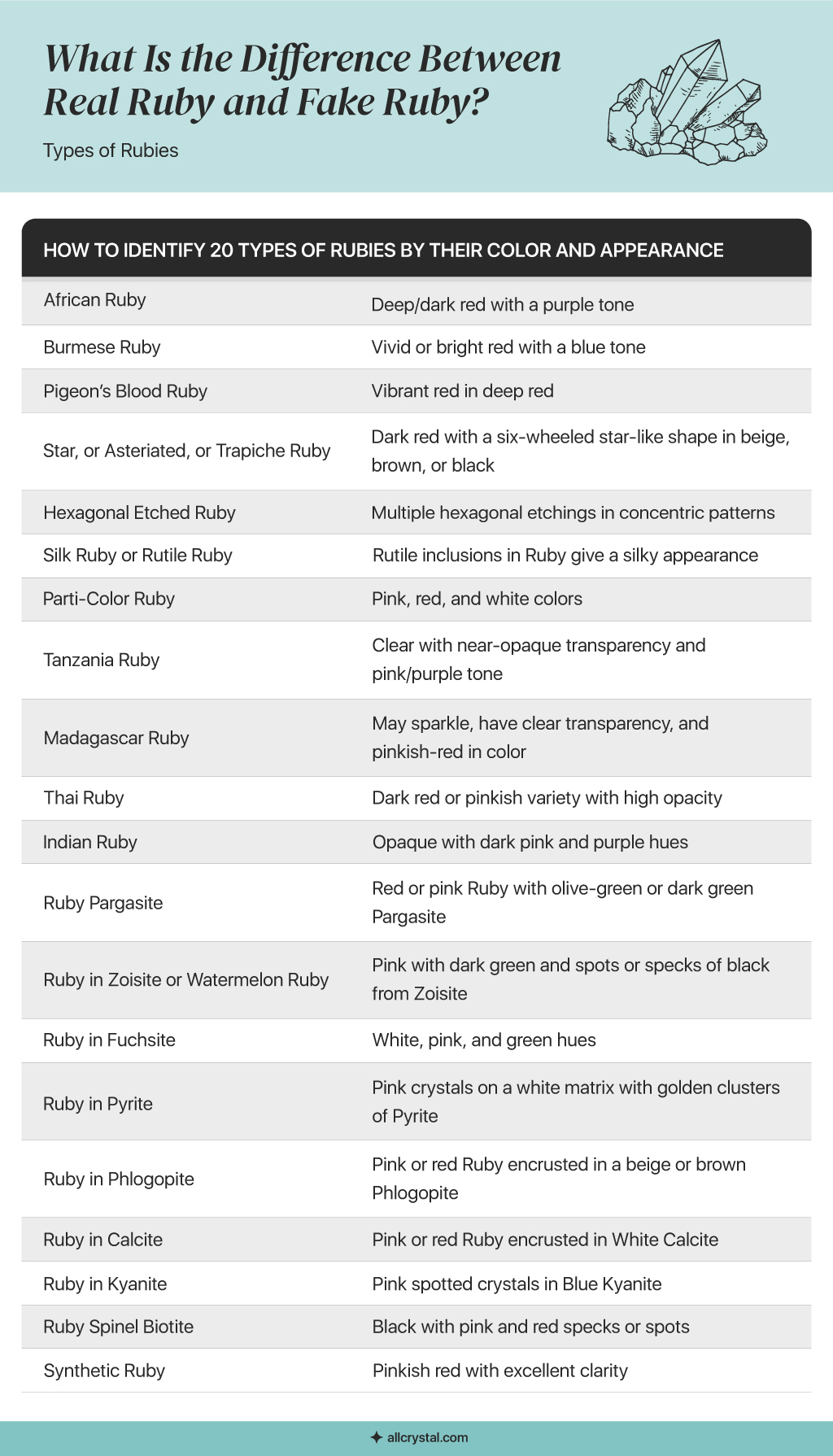
How To Tell if Ruby Is Real: 7 Tests
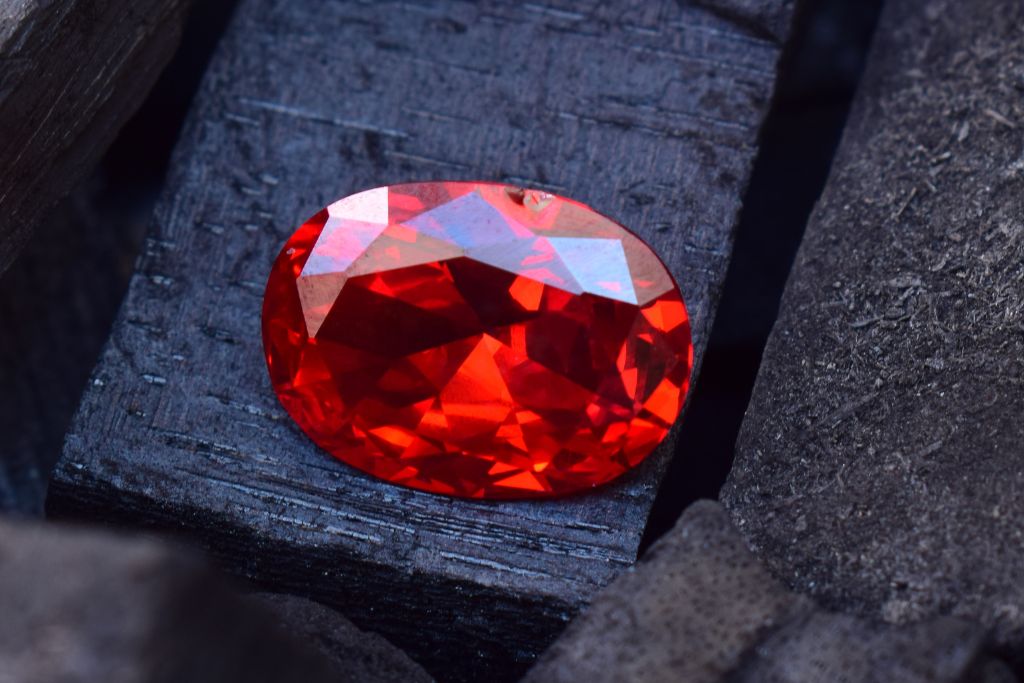
Disclaimer: Note that the following tests must be used in conjunction with multiple other tests before inferring. Some tests may damage the stone permanently. Mind the safety precautions and use personal protective equipment wherever necessary.
Weight Test
Most crystals, including Ruby, are denser than common rocks and pebbles of the same size. The only exceptions are Petrified Wood, Pearls, Lava Rocks, and Obsidian.
Fun Fact: Burmese or Myanmar Rubies are denser than the other varieties because they contain more iron and Chromium.
Steps
- Pick up your Ruby in the right hand.
- Pick the common pebble or rock in the left hand.
- Compare the sense of the weight of both stones.
Verdict
- Real Rubies are denser than common stones and pebbles.
Scratch Test
Ruby is harder than most crystals, like Amethyst, Peridot, Aquamarine, Garnet, Emerald, Tourmaline, and Topaz, so genuine is hard to scratch.
Steps
- Scratch your Ruby once with a window glass.
- After recording your results, scratch with a steel knife.
- Repeat for Quartz and Tourmaline crystals.
Verdict
- If it leaves a scratch from
- Glass: Not real, and your stone may be 5 or lower on the Mohs scale.
- Steel Knife: Not real, and the stone may be 6 or lower on the Mohs scale.
- Tourmaline: Not real, and the stone may be 8 or lower on the Mohs scale.
- Spinel: Not real, and the stone may be 8.5 or lower on the Mohs scale.
- Diamond: Real, and the stone may be lower than 10 on the Mohs scale.
Dye Test
Did you know a genuine Ruby consists of aluminum oxide? Natural Rubies don’t react with alcohol, iodine, and hydrochloric acid, whereas synthetic and fake Rubies may warp, melt, or discolor.
Steps
- Wear gloves.
- Dissolve a few drops of iodine in a few drops of isopropyl alcohol in a plastic cup.
- Dip a cotton swab in the solution.
- Rub the soaked swab on your stone.
- Let the solution dry on the crystal for 7 to 10 minutes.
- Rinse the stone with tap water.
Verdict
- Genuine Rubies don’t change color, while Fake Rubies may discolor, warp, or reveal other colors.
Note: Real Rubies also don’t melt or crack quickly, as glass or most common fakes, so you can try holding the stone in front of a flame to check for melting dye.
Light Test
Like most other healing stones, Ruby is a birefringent gemstone with a high refractive index. It splits the ray of light into two, giving a bright, deep, and vibrant appearance to natural rubies.
Synthetic Rubies may also split the image into two, but weakly.
Steps
- Place your stone on a flat surface with the pointed end facing upward.
- Place a pencil behind the stone to align it with the upward-facing point.
- Look at the pencil through the Ruby.
Verdict
- Genuine Rubies split light into two rays and create a double image, so you should see two pencils.
Fluorescence Test
Genuine Rubies fluoresce due to Chromium in their composition. Some natural Rubies have a weak to negligible fluorescence, much like Garnet, Red Tourmaline, and Spinel.
Steps
- Turn off the light and wear your safety goggles.
- Turn on the UV lamp (365nm and 254nm) close to the Ruby stone.
- Observe and record the color.
Verdict
- Synthetic and Natural Rubies fluoresce with a strong red color under UV light.
Heat Test
Like common stones and pebbles, Ruby feels calming and cold to the touch because they have a higher density and thermal conductivity, helping them absorb heat fast.
Steps
- Pick up the Ruby with your right hand and the pebble with your left.
- Wrap your fingers around the stones for two minutes.
- Place the Ruby and the pebble on the table without touching each other.
- Leave them undisturbed for a minute.
- Compare the temperatures.
Verdict
- Ruby, like natural crystals, is cold to the touch and cools quickly, even when heated. But fakes will feel warm to the touch and remain the same.
Streak Test
The streak is the powder left behind by a crystal when it’s scratched against a hard surface. You can try scraping on Quartz concrete, unglazed porcelain tile, or a Diamond file.
Steps
- Scrape your stone against the hard surface of your choice.
- Collect the powder scraped off the stone.
Verdict
- Real Rubies leave a white streak or powder when scraped against unglazed.
How To Spot a Fake Ruby: 5 Telltale Signs
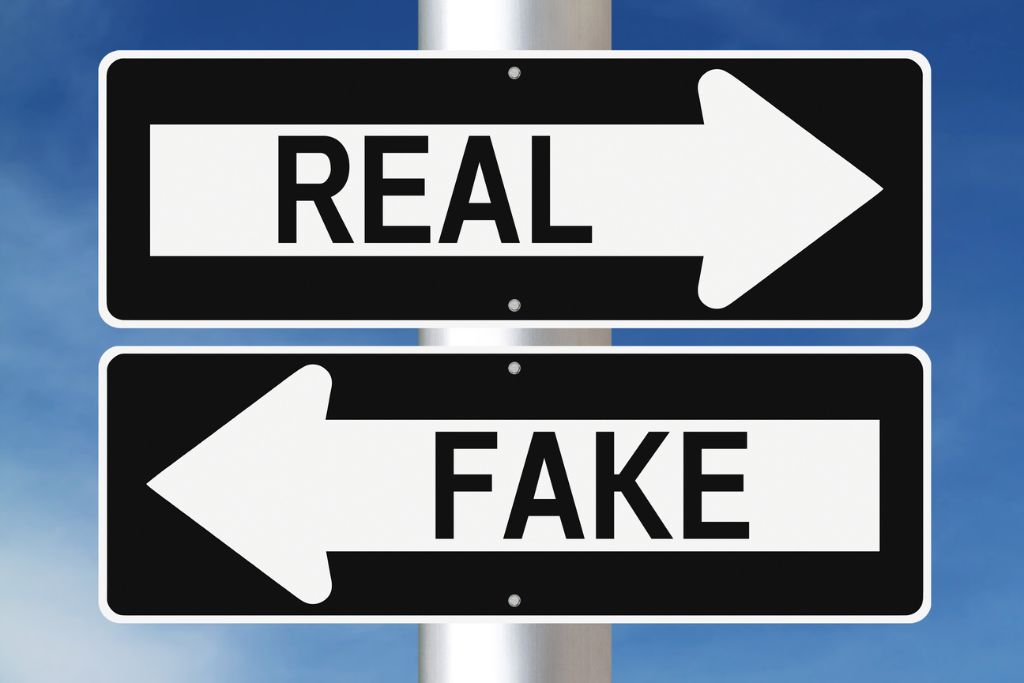
Fake Rubies are getting harder to differentiate because materials like glass, synthetic stones, simulants, and cubic zirconia are used for making fake Rubies.
Here are their common signs:
- Strange names, like Bohemian Ruby, Hyacinth Ruby, Montana Ruby, or Ruby Spinel.
- Unrealistically large and flawless Rubies don’t exist.
- The uniformity of the growth lines is seen in Synthetic Rubies.
- Bubble-like inclusions are a sign of glass and not genuine Rubies.
- Cheap Rubies are fake because real ones cost $50 to $1,180,000 per carat.
Verdict: Real Ruby Vs. Fake Ruby
High-quality Rubies have been costly for hundreds of years due to their captivating color and powers related to the Root and Heart Chakras. It’s good for strength, power, fertility, psychic visions, protection, health, vitality, and good luck.
Fakes are usually made from Spinel, Synthetic Corundum, Quartz, Garnet, or Glass. How to identify raw ruby and its polished alternatives?
You can identify a real Ruby from its luster, fluorescence, color change, transparency, structure, composition, growth lines, size, and rarity. Testing them by weight, hardness, heat, light, UV light, and the streak is also good to find out if you have a real Ruby.
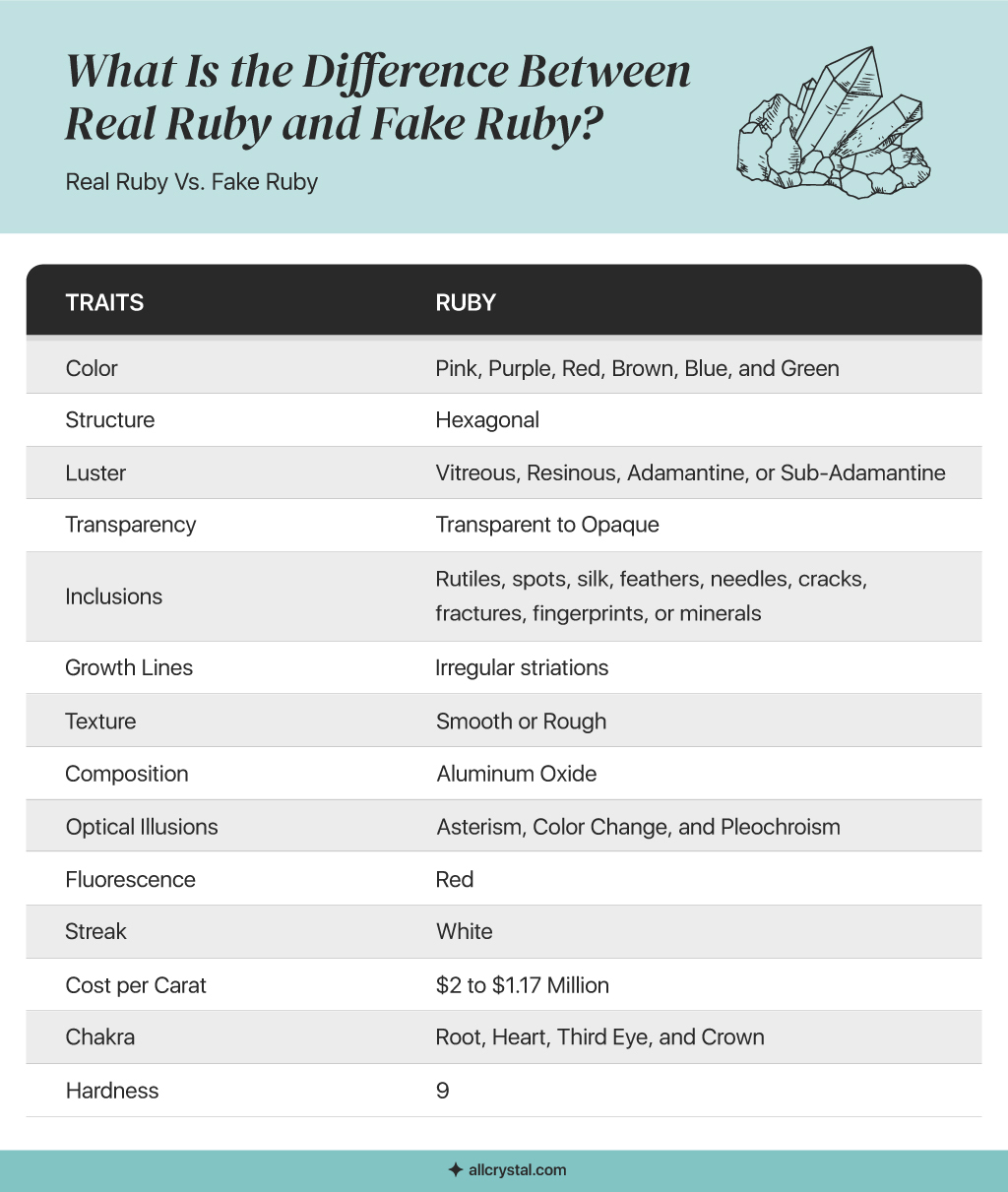
Pro Tip: Identify real Rubies are specific gravity and the HCL acid test.


